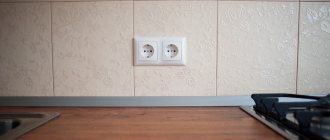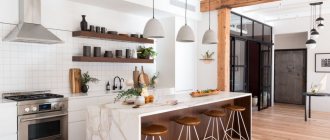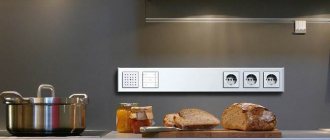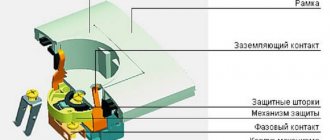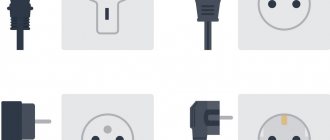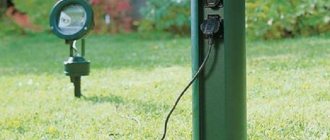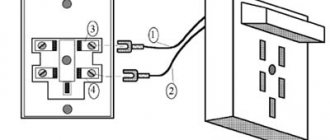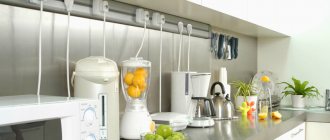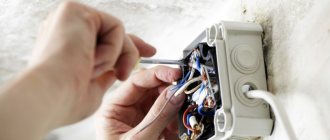Tips and regulations for installing sockets in the kitchen
- Sockets should be located at a distance exceeding two centimeters from the baseboard. The most convenient way to place sockets is when they are installed 10 - 20 cm above the kitchen countertop;
- If there are small children in the house, it would be a good idea to equip sockets with special plastic plugs;
- A household appliance that is powered from the mains should be placed no further than one meter from the outlet;
- Make sure that drops of water or hot steam do not fall on the electrical components.
Together or apart?
The layout of sockets in the kitchen can be separate or combined. Large household appliances - water heater, electric stove, washing machine - consume a lot of energy and operate independently of each other. Therefore, each of these devices needs its own power supply line.
Using combined lines, you can significantly simplify the power supply circuit, optimize the location of outlets in the kitchen and reduce costs. But it is important that this work is carried out under the guidance of a competent craftsman who knows all the nuances. For example, the total power of devices connected to the network should be a maximum of 4 kW, and their simultaneous operation should be minimal.
One supply line is often used when it comes to work area outlets. They usually include small household appliances with low power. Therefore, what comes to the fore is not the calculation of total energy consumption, but the convenience of location.
What else you should remember is the mandatory protection of the line with the help of an RCD. Don’t skimp on this equipment – your peace of mind and safety directly depend on it.
Corner sockets for the kitchen
This option is the most convenient and rational for the kitchen space. Sockets are most often installed under hanging cabinets. This method is used to place both single sockets and modular sockets consisting of several at once. Installing such sockets is no different from installing the simplest ones.
Hidden sockets in the kitchen
This is an innovative solution to the problem of rational use of space and arrangement of kitchen equipment. Such sockets can be installed vertically or horizontally, placed in a closet or even mounted into a countertop. Often such a solution is put into practice already at the stage of manufacturing the kitchen set. The aesthetic appearance of such sockets is guaranteed. Such sockets are protected from the outside with aluminum covers. Inside such a system there can be several sockets at once, as well as connectors for connecting gadgets.
Bathroom
| vendor code | Description | Price including VAT, rub. | Quantity, pcs. | Cost including VAT, rub. |
| 1E10201300 | Grounding socket, screw terminals, white | RUR 154.00 | 7 | RUR 924.00 |
| 1E31301300 | Single switch, white | RUB 157.00 | 1 | RUB 157.00 |
| 1E52101300 | Single frame, white | RUB 33.00 | 2 | RUB 66.00 |
| 1E52301300 | Triple frame, white | RUB 97.00 | 2 | RUR 194.00 |
| Total for bathroom | 1341 rub. |
The bathroom has a washing machine and dryer, 1 socket is provided as a reserve (3 sockets in a triple frame). On the other wall there are sockets for a hair dryer, a charging station for an irrigator and an electric razor. There is a light switch in a single frame at the entrance to the bathroom. For the illuminated mirror there is a rosette in a single frame. It is located behind the mirror.
Pull-out socket systems for the kitchen
If you are tired of the endless tangle of extension cords in your kitchen, then this is the choice for you. Retractable systems can be hidden in a countertop or in a drawer of a kitchen unit, thus hiding them from dust and moisture. In addition, they are easy to “hide” when they are no longer needed.
How to connect with your own hands
Before creating sockets, draw a plan where you will place them
If the services of a professional electrician are unavailable or are expensive, you can connect the outlet yourself. Work should be done with rubber gloves.
Algorithm of actions:
- de-energize the apartment by turning off the power supply at the panel;
- use an indicator to check the lack of current in the socket;
- if there is no indicator, you can use a small electrical appliance for this, checking if it works;
- remove the old socket, disconnecting the wires;
- prepare the socket box by cleaning the old one or using a new one;
- wires must be open for work;
- strip the ends of the wires (up to 1.5 cm) and solder if necessary;
- connecting wires to a new outlet makes it easier to use different colors;
- We connect the white (it can be red) wire to the phase, the blue wire to the “zero”, the yellow-green wire to the ground;
- Each wire is checked with a phase indicator. Exposed wires should not touch open areas of the body;
- the working part of the socket is inserted into the socket box and securely attached with screws or special clamps;
- install the outer cover for the socket, secure it with a screw without overtightening; connect the current.
Read how to connect a ceiling island hood here.
How to install the socket correctly, watch the video:
Common mistakes when placing sockets in the kitchen
- Pay attention to the total power of all kitchen electrical equipment connected to the network. This value should not exceed the maximum permissible level.
- You cannot plug a kettle and a microwave into the same socket block at the same time. The power of the equipment is always indicated in their technical data sheets. For electrical equipment with high power (large-sized equipment), it would be more correct to lay separate lines with the correct cross-section, copper and using protective automatic equipment. In order not to be mistaken with the power, stick small pieces of paper with explanations on each machine in your electrical panel.
- Equipment with a metal casing must be grounded.
Receptacles supplying power to this equipment must be connected through a residual current device. It is highly undesirable to install sockets directly behind built-in electrical equipment. This may lead to undesirable consequences. The power source should be located no closer than 20 cm. The sockets should be mounted above the working surface, placing 10-15 cm vertically upward. It is important to remember that drops of water, grease and any other moisture should not come into contact with the electric current sources. Never install sockets directly above a sink or near water pipes.
- Always carefully study the information that the manufacturer indicates on their products: what is the maximum power permissible for their safe and proper use.
Where and how much to place
At the stage of planning sockets, you should add 3 more points to the number of standard devices. With their help, you can connect additional equipment that is used from time to time.
For example, with standard equipment with a TV in the kitchen there are 9 points, of which 6 are close to the equipment, a unit in the apron, one in the area of the dining table and another element in any convenient place.
Exact calculations are carried out only taking into account the wishes of the owners. Some people prefer to place everything in a visible place, so it is better to provide separate electrical points for each equipment. In the kitchen, 10 meters of space is not enough, so unnecessary equipment is hidden and taken out as needed. It is better for her to place the block on the apron.
Correct placement is possible only after a preliminary plan has been made, taking into account equipment and furniture. After creating a plan, the number and location of sockets is determined - taking into account that the wires are often about 1-1.5 m. With a total equipment power of up to 3.5 kW, you can install dual types suitable for stationary devices.
Devices constantly connected to the network
The number of sockets for each kitchen and owner is different, but the standard set of equipment that needs constant connection is almost always the same:
- electric ovens are the most powerful equipment, some models can take 5–6 kW, so a power outlet and a separate line must be used;
- electric stove or hob - each of the burners requires up to 2 kW, so simultaneous activation requires a separate line and a powerful outlet. Induction options can also be used, but electric points should be placed away from other equipment;
- dishwasher - for operation and heating of water, a heating element is used, which requires the most energy. The power of the device is 1.5–2 kW, but since it is used infrequently, it can be plugged into ordinary overhead sockets with one line for other household appliances;
- multicooker - used for cooking, the average operating period is about 1 hour. The power is 2 kW, and it is recommended to use separate sockets or dual sockets with low-power appliances. Similar rules apply to bread makers;
- microwave, kettle - the equipment is quite powerful, but it only works for 5-10 minutes. They can be plugged into a double socket and activated simultaneously;
- refrigerator - requires separate power, the power of the device is small, installation is done separately. It is recommended to install external socket options, single or double;
- a hood is a low-power appliance; any furniture socket will do if the electrical outlet is inside the cabinet, or the usual options that are installed near the ceiling behind the appliance itself. Separate power supply should be provided for TV or radio.
As a result of what has been described, there are 5–6 devices constantly on the network. Based on location, functionality and power, different models of sockets are suitable, but when calculating, a reserve is always made, taking into account that other equipment will be turned on periodically.
Devices that are connected separately
After drawing up a diagram and determining the amount of equipment and sockets for it, it is important to take into account the availability of combines, blenders, coffee machines and other things. This technique turns on from time to time, but it requires a free electric point. It is often done in blocks of 2-3 power sources near the dining table or on the apron.
Read more about installing sockets for lighting and equipment in an apron here.
For those who like to use phones and other gadgets, you can place a point near the table to charge devices. To simplify cleaning, there is one outlet at the bottom of the room, which is suitable for connecting a vacuum cleaner.


